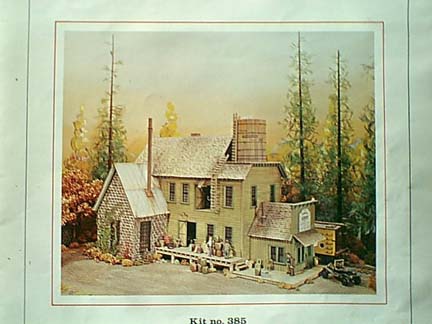
A little extra detail upgrades this structure. Roof flashing, Cap on masonry chimney and spark arrester on the metal chimney. The upper floor is cantilevered over the first floor. Notice the flashing around the masonry chimney. A weathered plank walkway surrounds the false front business office.
About This kit from Campbell Scale Models
#385, Bret’s Brewery Kit HO scale: A Craftsman kit ideal for a local industry close to a town. One modeler even put ducks swimming in the water tank that fed the brewery. It gave the beer that extra snappy taste. This craftsman kit consists of scale lumber (sugar pine), printed card stock, inject-molded doors/windows, Campbell’s famous realistic shingles, and sheet aluminum roofing. It is ready for paint and weatherizing. Complete instructions, drawings, and templates are included. This is a laser-cut kit. Our picturesque Brewery was originally conceived through the fertile imagination of Mr. Denis Dunning of Sierra Madre, California. The scratch-built model was designed for his own model railroad layout. Later it was used on the Pasadena Slim Gauge Guild layout, a club of which Denis was a member. Photographs of the structure in the club setting have been reproduced many times in leading model railroad magazines. A few minor structural deviations have been made to make the building more suitable for a kit, and we have added various types of sidings and roofing materials for some challenging effects. But in general, the kit is much like the original Brewery model and hours of enjoyment are offered in its construction.
[Campbell Scale Models]
BREWERIES PRE-WORLD WAR
COMMERCIAL BREWING ARRIVES IN NORTH AMERICA
Commercially, the first brewery in the United States was set up in New Amsterdam (now New York City) on Brewer Street (now Stone St.) in the early 17th century. It was opened by the Dutch West India Company, who had received orders to build the area as a Dutch settlement. Commercial brewing was not as common at the time. Beer was something that everyone brewed individually, so there was not yet a need for a separate entity to do it. The Dutch were pioneers in the efficiency of trade. A century earlier, they fortified wine as a way to ship more of it, expecting to add water back to it when it arrived at its destination. They built breweries to make sure that the few hundred settlers on the island were spending their time developing the land without having to worry about making beer.
Breweries slowly manifested across the new country as settlers moved further and further into the new world. As populations grew, breweries served several functions. Initially, when settlers arrived in a new location, they would brew on their own. Most new structures had a place to set up an area for brewing, but homebrewing could be incredibly dangerous. Many fires occurred when bringing everything to boil. With a separate brewery, the home was a little bit safer. It also brought an economic boost to the area. In many settlements, breweries and taverns were typically the first buildings there, to encourage people to either stop in an established area or travel to a new one. Commercial brewing helped encourage the growth of the colonies beyond the coastlines and deeper into the new world.
THE PROHIBITION AND WORLD WAR
In April 1933 Congress amended the Volstead Act to allow for 3.2 percent beer. Eight months later, in December, Congress and the states ratified the Twenty-first Amendment, officially repealing Prohibition. From repeal until World War II, the brewing industry struggled to regain its pre-Prohibition fortunes. Prior to prohibition, breweries owned or controlled many saloons, which were the dominant retail outlets for alcohol. To prevent the excesses that had been attributed to saloons from reoccurring, post-repeal legislation forbade alcohol manufacturers from owning bars or saloons, requiring them instead to sell their beer to wholesalers that in turn would distribute their beverages to retailers.
During the thirteen years that Prohibition was in existence, just over 40% of the 1,356 breweries running in the mid-1910s were still operating. Those that made it through took some very innovative routes to do so. Less than 1% beer was allowed to be brewed, which many brewers attempted to do with varying degrees of success. Some made malt extract for bakers and parts of the food industry. (Though if the concoction was exposed to yeast and some water, there may be the “unfortunate” side effect of making beer.) With all of the refrigeration equipment they owned, many breweries transitioned into the dairy industry, making cheese or ice cream.
